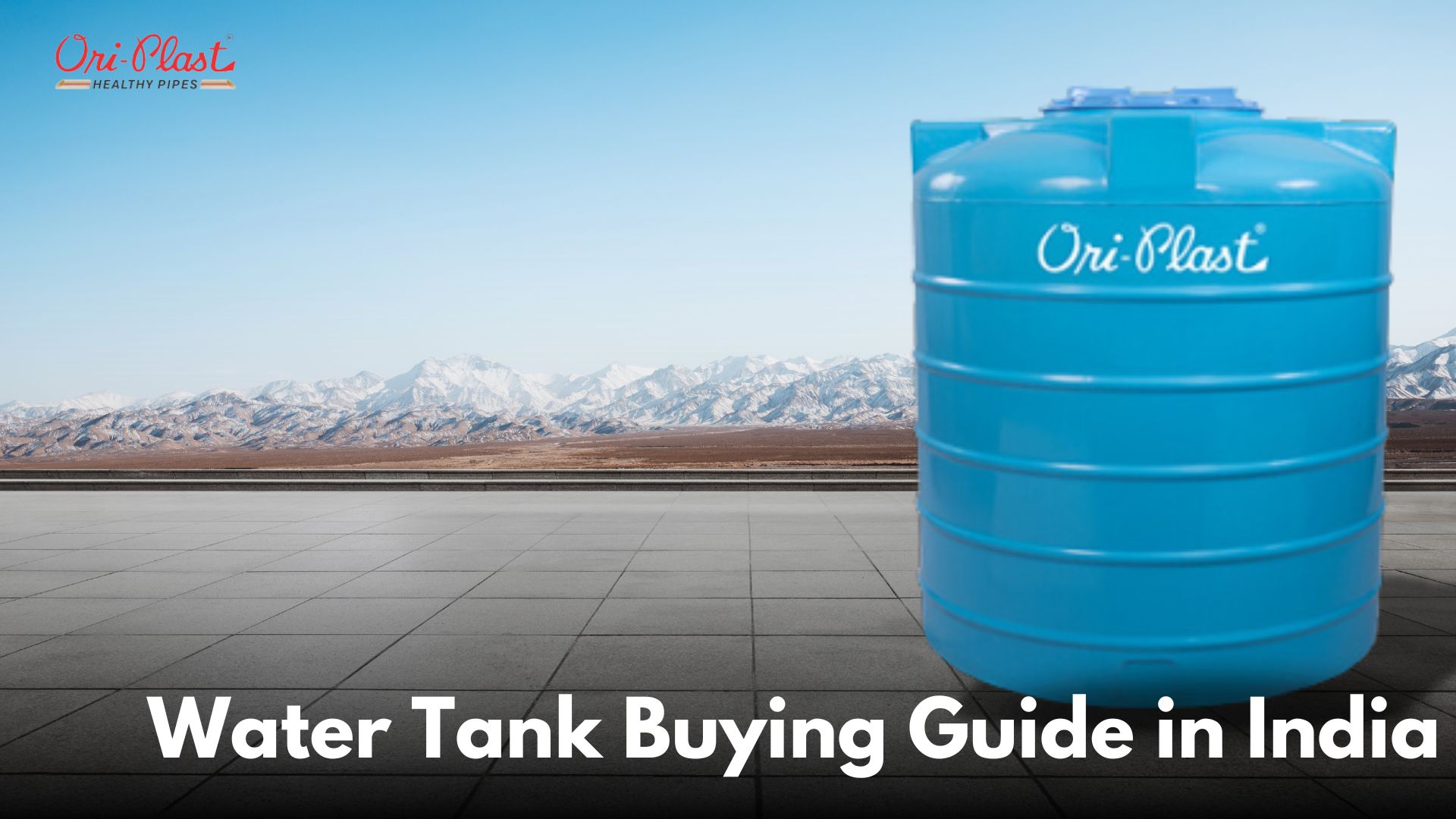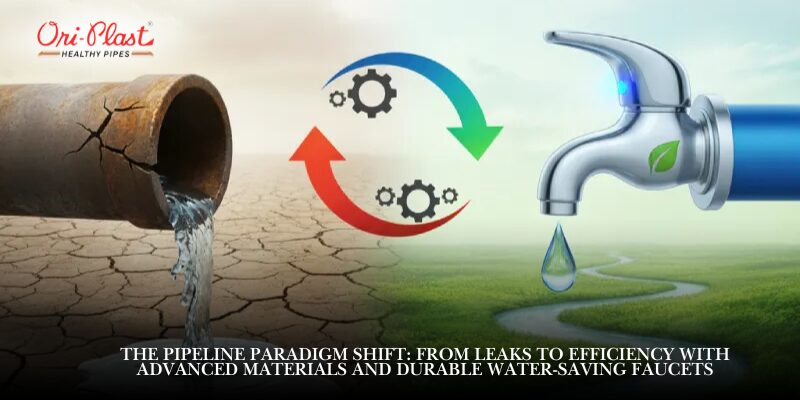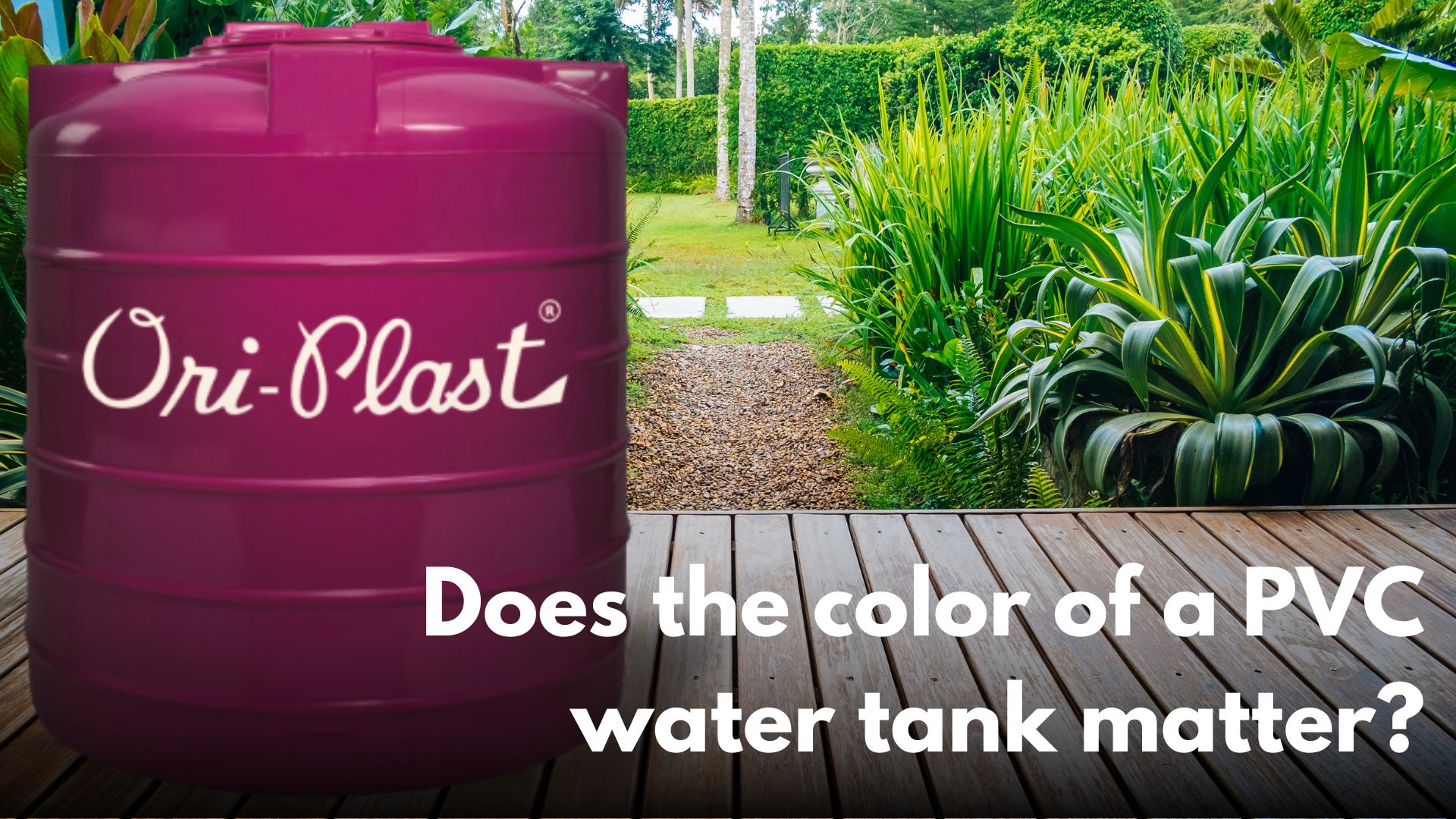Water is essential for every household, and having a reliable water storage solution is crucial, especially in India, where water supply can be inconsistent. Whether you're building a new home or upgrading your existing water storage system, choosing the right water tank can make a significant difference in your daily life. This comprehensive guide will walk you through everything you need to know about buying a water tank in India, from understanding different types of tanks to selecting the right size and material.
Understanding the Importance of a Water Tank
Why Do You Need a Water Tank?
In many parts of India, the municipal water supply is often not available around the clock. Having a water tank ensures that you have a steady supply of water for your household needs, even when the main supply is temporarily unavailable. Water tanks are also useful in areas where water pressure is low, allowing you to store water at your convenience and use it when needed.
Benefits of Having a Water Tank
- Uninterrupted Water Supply: A water tank provides a consistent water supply, ensuring you have water even during shortages.
- Emergency Backup: In case of any issues with the water supply, a tank acts as a backup, reducing the inconvenience.
- Water Conservation: Storing rainwater in tanks can help in conserving water, which is particularly important in water-scarce regions.
- Cost Savings: Properly managing your water usage with a tank can help reduce water bills, especially in areas where water is metered.
Different Types of Water Tanks Available in India
1. Plastic Water Tanks
Overview: Plastic water tanks are the most common type used in Indian households. They are lightweight, durable, and come in various sizes and shapes.
Advantages:
- Durability: Resistant to corrosion and can withstand harsh weather conditions.
- Affordability: Generally less expensive compared to other materials.
- Easy Installation: Being lightweight, they are easier to install.
Disadvantages:
- UV Degradation: Prolonged exposure to sunlight can cause degradation, though most tanks come with UV protection.
- Chemical Contamination: Low-quality plastic may release chemicals into the water over time.
2. Steel Water Tanks
Overview: Steel tanks are known for their strength and durability. They are mostly used in commercial settings but are also suitable for homes.
Advantages:
- Longevity: Resistant to physical damage and last longer.
- Hygiene: Less likely to contaminate water, ensuring safe drinking water.
Disadvantages:
- Cost: More expensive than plastic tanks.
- Maintenance: Prone to rust and corrosion, requiring regular maintenance.
3. Concrete Water Tanks
Overview: Concrete tanks are typically used for underground storage. They are sturdy and long-lasting.
Advantages:
- Strength: Highly durable and can last for decades.
- Temperature Control: Concrete tanks keep water cool even during hot weather.
Disadvantages:
- Installation: Requires professional installation, which can be costly.
- Weight: Heavy and not suitable for above-ground installation.
4. Fiberglass Water Tanks
Overview: Fiberglass tanks are less common but offer some unique advantages, especially for specific uses.
Advantages:
- Corrosion Resistance: Unaffected by rust or chemical reactions.
- Lightweight: Easier to transport and install.
Disadvantages:
- Cost: More expensive compared to plastic tanks.
- Availability: Less widely available in India.
Choosing the Right Size for Your Water Tank
1. Assessing Your Water Needs
The first step in choosing the right tank size is to assess your household’s daily water consumption. Consider factors like the number of people in the household, average water usage per person, and specific needs like gardening or washing vehicles.
Average Consumption Estimates:
- Drinking and Cooking: 10-15 liters per person per day.
- Bathing: 30-50 liters per person per day.
- Cleaning and Laundry: 20-30 liters per person per day.
2. Understanding Tank Capacity
Water tank capacities in India are usually measured in liters. Common sizes range from 500 liters to over 10,000 liters. Here’s a quick guide to help you decide:
- Small Household (1-2 People): 500-1000 liters.
- Medium Household (3-5 People): 1000-2000 liters.
- Large Household (6+ People): 2000-5000 liters.
If you have additional water needs, such as for a garden or livestock, you may need a larger tank.
3. Planning for Future Needs
When choosing a tank, it’s wise to consider future needs as well. For example, if you plan to expand your home or add more members to your household, opting for a slightly larger tank can save you from needing an upgrade later.
Material Considerations for Water Tanks
1. Plastic (Polyethylene) Tanks
Plastic tanks are made from polyethylene, a material that is durable, lightweight, and resistant to most chemicals. These tanks are available in a variety of colors, with black and green being the most popular due to their ability to block sunlight, reducing algae growth.
Pros:
- Versatile: Available in a variety of shapes and sizes.
- Non-reactive: Safe for storing potable water.
Cons:
- UV Damage: Lower-quality plastics may degrade over time if exposed to sunlight.
2. Steel Tanks
Steel tanks are usually made from galvanized steel or stainless steel. They are extremely strong and can last for many years if properly maintained.
Pros:
- Durability: Can withstand extreme weather conditions.
- Hygiene: Less likely to contaminate water.
Cons:
- Cost: Higher initial investment.
- Corrosion: Needs regular maintenance to prevent rust.
3. Concrete Tanks
Concrete tanks are known for their robustness and are typically used for underground storage. They are excellent for large-scale water storage needs.
Pros:
- Longevity: Can last for decades without needing replacement.
- Thermal Insulation: Keeps water cool in hot climates.
Cons:
- Installation: Requires professional installation and is not easily moved.
- Cracking: May develop cracks over time, leading to leaks.
4. Fiberglass Tanks
Fiberglass tanks are made from reinforced plastic and are highly resistant to corrosion. They are ideal for storing water in chemically aggressive environments.
Pros:
- Corrosion Resistance: Suitable for storing a variety of liquids.
- Lightweight: Easier to handle than concrete tanks.
Cons:
- Cost: More expensive than other options.
- UV Exposure: Can degrade if not properly protected from sunlight.
Placement Options: Above-Ground vs. Underground Tanks
1. Above-Ground Water Tanks
Overview: These are the most common type of water tanks in India. They are installed on the roof or ground level, making them easily accessible for maintenance.
Advantages:
- Easy Installation: Simple to install and connect to your water system.
- Cost-Effective: Generally less expensive than underground tanks.
Disadvantages:
- Space: Requires adequate space, which might be a constraint in small properties.
- Temperature Fluctuation: Water temperature may vary significantly depending on the weather.
2. Underground Water Tanks
Overview: Underground tanks are buried below the ground and are ideal for those who have space constraints or want to keep the tank out of sight.
Advantages:
- Space-Saving: Doesn’t take up valuable ground space.
- Temperature Stability: Maintains a more consistent water temperature.
Disadvantages:
- Installation Costs: More expensive to install due to excavation and other requirements.
- Maintenance: Harder to access for cleaning and repairs.
Water Tank Design and Shape Considerations
1. Cylindrical Tanks
Cylindrical tanks are the most common shape and are known for their strength and efficiency in water storage.
Pros:
- Structural Integrity: The cylindrical shape is inherently strong, reducing the risk of leaks.
- Easy Cleaning: Smooth interior walls make cleaning easier.
Cons:
- Space Requirements: May require more space compared to other shapes.
2. Rectangular Tanks
Rectangular tanks are often used when space is limited, as they can fit into corners and against walls more easily than cylindrical tanks.
Pros:
- Space Efficiency: Can be installed in tight spaces.
- Aesthetic Appeal: May blend better with the architecture of a building.
Cons:
- Stress Points: The corners of rectangular tanks are prone to stress, which may lead to cracking over time.
3. Spherical Tanks
Spherical tanks are less common but offer maximum storage with minimal surface area, which reduces the risk of contamination.
Pros:
- Compact Design: Occupies less space compared to other shapes.
- Strength: The shape provides natural strength, minimizing the risk of damage.
Cons:
- Limited Availability: Harder to find in the market.
- Aesthetics: May not be as visually appealing as other shapes.
Essential Features to Look for in a Water Tank
1. UV Protection
In India’s harsh sun, UV protection is crucial to prevent the degradation of the tank material. Look for tanks that are made with UV-stabilized material to ensure a longer lifespan.
2. Algae Resistance
Tanks that are opaque or dark in color help in preventing the growth of algae inside the tank. Algae can contaminate the water and cause it to smell, making it unfit for use.
3. Food-Grade Material
For drinking water storage, ensure that the tank is made from food-grade material. This prevents chemicals from leaching into the water, keeping it safe for consumption.
4. Multi-Layer Construction
Multi-layer tanks offer added protection against external elements and are better at maintaining water quality. The layers typically include UV protection, insulation, and a food-grade inner layer.
5. Overflows and Vents
Proper ventilation is essential to maintain water quality. Look for tanks that come with vents to allow air circulation. Overflows are also important to prevent water from spilling out if the tank is overfilled.
Installation Considerations
1. Professional vs. DIY Installation
While some tanks, especially smaller plastic ones, can be installed by homeowners themselves, larger tanks or those made from materials like concrete or steel often require professional installation.
2. Site Preparation
The area where the tank will be placed should be flat and stable. For above-ground tanks, ensure that the base is strong enough to support the weight of the tank when full. For underground tanks, proper excavation and leveling are crucial.
3. Connecting to the Water Supply
Once installed, the tank needs to be connected to your home’s water supply system. This may involve installing pumps, pipes, and valves, depending on the setup. Professional help is often recommended for this step to ensure that everything is properly connected and there are no leaks.
Maintenance Tips for Longevity
1. Regular Cleaning
To maintain water quality, it’s essential to clean your tank regularly. This involves draining the tank, scrubbing the interior walls, and rinsing it out before refilling. Depending on your usage, this should be done at least once a year.
2. Inspect for Leaks
Regularly inspect your tank for any signs of leaks, especially around joints and fittings. Addressing leaks early can prevent water wastage and prolong the life of your tank.
3. Check for Algae Growth
If you notice any algae growth, clean the tank immediately. Using an opaque or dark-colored tank can help reduce the chances of algae forming.
4. Monitor Water Quality
If you’re storing drinking water, it’s crucial to monitor the water quality regularly. Test for any signs of contamination, such as unusual smells or colors, and address any issues immediately.
Cost Considerations
1. Initial Purchase Cost
The cost of a water tank varies widely depending on the material, size, and brand. Plastic tanks are usually the most affordable, while concrete and steel tanks are more expensive. Fiberglass tanks tend to be the most costly due to their specialized nature.
2. Installation Costs
Installation costs can add significantly to the overall expense, especially for larger or underground tanks. Be sure to factor in the cost of site preparation, installation, and any additional plumbing work required.
3. Maintenance Costs
While plastic tanks require minimal maintenance, steel and concrete tanks may require regular upkeep to prevent rust or cracks. Over time, these costs can add up, so it’s important to budget for them.
4. Long-Term Value
When choosing a tank, consider the long-term value. A more expensive tank that lasts longer and requires less maintenance may be more cost-effective in the long run than a cheaper tank that needs frequent repairs or replacement.
Choosing the Right Brand
1. Top Water Tank Brands in India
Several brands are known for producing high-quality water tanks in India. Some of the most popular include:
- Sintex: Known for its durable plastic tanks, Sintex is one of the most trusted brands in India.
- Supreme: Offers a wide range of tanks in various sizes and materials.
- Plasto: Known for its UV-resistant tanks, ideal for India’s hot climate.
- Vectus: Offers multi-layered tanks with advanced features like algae resistance.
- Nexus: Provides high-quality fiberglass tanks, suitable for specialized needs.
2. Brand Reputation
When choosing a brand, consider its reputation for quality and customer service. Reading customer reviews and seeking recommendations from friends or family can help you make an informed decision.
3. Warranty and After-Sales Service
A good warranty is a sign of the manufacturer’s confidence in their product. Look for tanks that come with a long warranty period. Additionally, consider the availability of after-sales service, as this can be crucial if you encounter any issues with your tank.
Environmental Considerations
1. Eco-Friendly Materials
If environmental sustainability is important to you, look for tanks made from recyclable materials or those that have been manufactured using eco-friendly processes.
2. Rainwater Harvesting
Using your water tank for rainwater harvesting can significantly reduce your reliance on municipal water supply, especially in areas where water is scarce. Many modern tanks are designed to be easily integrated into a rainwater harvesting system.
3. Water Conservation
By storing water efficiently, tanks help in reducing wastage and promoting water conservation. In a country like India, where water scarcity is a growing concern, investing in a good water tank is not just about convenience but also about contributing to sustainable water management.
Common Mistakes to Avoid
1. Choosing the Wrong Size
One of the most common mistakes is buying a tank that is either too small or too large for your needs. It’s important to accurately assess your water usage before making a purchase.
2. Ignoring Material Quality
While it might be tempting to go for the cheapest option, low-quality materials can lead to problems down the line. Always prioritize quality and durability over cost savings.
3. Neglecting Maintenance
Even the best tanks require regular maintenance to function effectively. Neglecting this can lead to water contamination, leaks, and other issues.
4. Poor Installation
Improper installation can lead to a host of problems, including leaks, improper water flow, and even tank failure. If you’re not confident in your DIY skills, it’s worth hiring a professional.
Conclusion
Investing in a high-quality LLDPE water tank is a crucial decision for every household in India. With so many options available, it’s important to consider your specific needs, the local climate, and your budget. By understanding the different types of tanks, materials, sizes, and features, you can make an informed choice that ensures a reliable and safe water supply for your home. Remember, while cost is an important factor, quality and durability should always be at the forefront of your decision-making process. Happy tank shopping!




